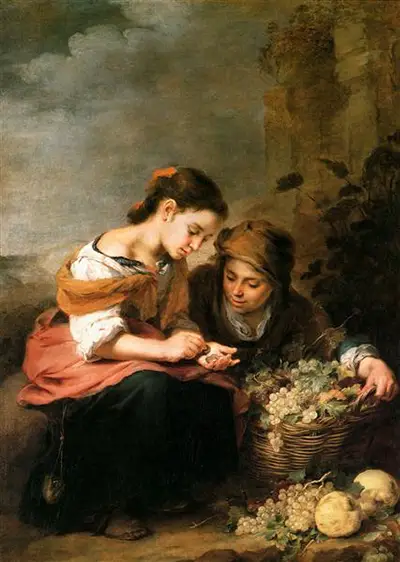This charming artwork was completed by Bartolomé Esteban Murillo in around 1670-75 and it was part of his genre painting body of work which proved particularly popular with North European patrons. He would capture the ordinary lives of local people and from that create charming depictions such as this.
In front of us here we find a fruit seller sat on the ground whilst in conversation with another young girl. One immediately recalls the work of academic artist Bouguereau, with paintings such as The Shepherdess and The Young Shepherdess. Murillo himself provided a real charm to his portraits and a sensitive touch that few Spanish painters had been able to achieve in the 17th century, or indeed before that. We find a young girl checking her coins to see what she might be able to purchase, whilst the seller protects her overflowing basket which contains a variety of different fruits. The artist loved to capture the lives of people like this, and would generally depict them in a flattering, positive light, whatever their level of society happened to be. He would capture beggars as well as women from the upper classes, and many more in between. The particular elements to The Little Fruit Seller that make this painting memorable is the layers of clothing and how Murillo captures the drapery so accurately. One can also see a number of genres together in this composition, with still life fruit, portraiture, and then a touch of landscape in the background.
The overall painting measures 149cm in height and around 113cm in width, making it fairly large but about normal for artists of the 17th century. Of course, many would work on much larger canvases than this and sometimes call upon assistances in order to complete such ambitious challenges. When one considers the content of this painting it could easily be sad and negative, as a young girl is forced to work in order to pay for her family's food and lodgings. In reality, the artist manages to deliver this scene in an upbeat fashion which reminds us about he managed to achieve such popularity during his own lifetime.
The Little Fruit Seller can now be found in the permanent collection of the Alte Pinakothek in Munich, Germany. It is one of the few artworks by Murillo to be found in the country, with most dispersed across different collections in France, the UK, USA and the artist's native Spain. As someone who worked hard to sell his paintings abroad, it should be no surprise that his art would end up being quite so widely dispersed as this. There was also some looting carried out across Europe that would speed up the movement of his work away from Spain. Visitors to the exceptional collection of the Alte Pinakothek will also be able to spot some other notable artworks such as Virgin and Child (Madonna of the Carnation) by Leonardo da Vinci, Self-portrait (1500) by Albrecht Durer, The Land of Cockaigne by Pieter Bruegel and also Mystic Marriage of Saint Catherine by Lorenzo Lotto, though their collection is so large and impressive that it is impossible to really summarise it accurately with a selection of just a few items. They also have another Murillo painting here, Beggar Boys Eating Grapes and Melon.




